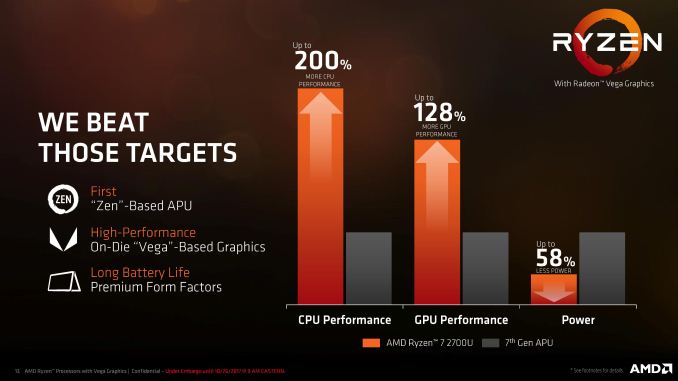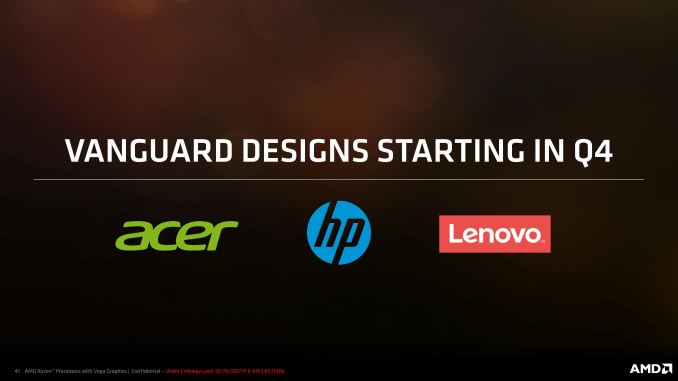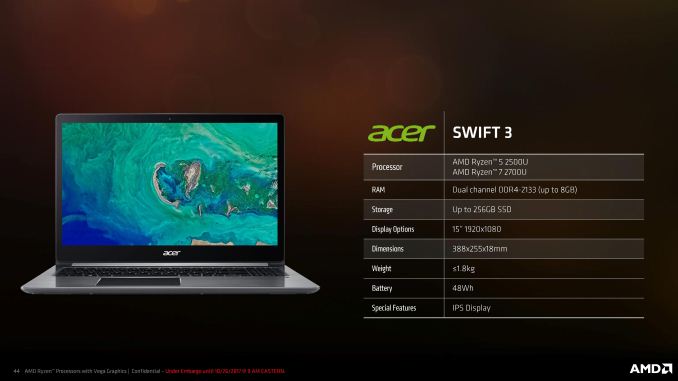Ryzen Mobile is Launched: AMD APUs for Laptops, with Vega and Updated Zen
by Ian Cutress on October 26, 2017 9:00 AM ESTAMD Ryzen Mobile: Zen 1.5
During our pre-briefings on Ryzen Mobile, it was asked why the two new APUs were using the 2000-series numbers, and not the 1000-series numbers like the desktop parts. It was assumed by the press that the first generation of Ryzen would all be under the 1000-series, including the mobile parts. The response given by Kevin Lensing, AMD’s Corporate VP of the Client Business Unit, was that so many of the design ideas that AMD wanted to put into the original desktop Ryzen (but couldn’t due to time) eventually ended up in Ryzen Mobile, such as the updated precision boost. While there are no architectural changes to Zen to warrant a next-generation microarchitecture name, this version of Ryzen’s periphery (i.e. the power) was more in-line with an original vision and had to be presented as such. This is why we have Ryzen 7 2700U, rather than a Ryzen 7 1700U. He would not comment if the true next generation Ryzen desktop naming would still be the 2000 series, or if we would go straight to 3000. Who knows, it might alternate.
The state of Zen aside, AMD’s return to high-performance computing with the Zen core was naturally going to trickle down into the notebook space. The question everyone asked is if such a high-power, high-performance core was going to make it in such a small power envelope: especially when you add some big graphics core next to it. In our desktop Ryzen reviews, we saw per-core power go as low as 8W per core, and AMD’s Vega was power hungry – promising to put four cores and some graphics into a single piece of silicon with a 15W TDP sounded harder than an uphill task, almost Sisyphean in nature. AMD has approached that by taking new methods to its power topology, how it manages that power, and found a combination of frequencies and performance that tally up to that 15W mark. They have also worked closely with the first three OEMs that are launching systems today to ensure a good user experience.
For performance, Ryzen Mobile has four cores with multithreading, with frequencies up to 3.8 GHz. This should give the mobile processor enough grunt under the hood in the 15W envelope to cater for a significant number of demanding workloads. GPU performance is also up, with AMD also hoping to push the hardware into a number of gaming-focused devices with FreeSync panels in the new few months. AMD is also touting significant power reductions during high-load tasks, leading to a 270% performance per watt improvement. More impressive is the steps taken towards how the processor manages power between cores and the GPU: a very complex implementation hopefully leading to a better power profile and 15-30% better battery life than previous generations for common use cases.
For the launch, AMD has partnered with HP, Acer and Lenovo for systems to go on shelves. As I am currently writing this, only HP provided any information about their upcoming systems and we’re likely to scramble when the other press releases come out. None of the three designs are ultimate eye-catching flagships, but rather approaching that middle-range $600-$1000 notebook territory with 13.3 inch 4K displays, up to 1TB SSDs, 48-55Wh batteries, and a device or two that can flip into a tablet. When we played briefly with the Acer unit in our pre-briefing, there was no lag – a user would be hard-pressed to immediately see a difference to a comparative Intel system.
Ultimately AMD has several very hard tasks ahead of it for Ryzen Mobile. Firstly it has to re-educate the sales teams at brick and mortar stores like Best Buy, who have only ever seen AMD has the low-cost budget option. If they still think the same way when Ryzen Mobile comes to town, they won’t be recommending them.
Second, they have to educate the public – after years of miserable user experiences leading to negative feedback loops, AMD has to convince these users that it is worth looking at AMD-powered devices again and there isn’t some sort of catch. Part of this solution will be in how well AMD integrates itself into the OEM sampling strategy for reviews, and if any reviewers are going to get devices this time around.
Third, AMD is several steps behind Intel in its marketing message: while Intel is trying to explain new ways to use the hardware (such as the failed ‘PC Does Whaaat?’ campaign almost a couple of years ago to the day), AMD is on the ‘I’m here too, and I’m just as good’ message. Back when we analyzed the Carrizo user experience, one thing we pointed out is that with most Intel flagships, most users do not even know what processor is inside – to these customers, saying ‘I’m just as good’ might give the impression ‘well what was wrong before?’. It might take AMD a round of flagships and XPS 13 or Zenbook Infinity-type designs to get the attention on their side of the discussion.
We have reached out to all three of the main OEMs who have Ryzen Mobile systems being announced today, but only one responded in time. This doesn’t bode well for any sampling, but we’re sitting here with a megaphone until we get one. Stay Tuned.
As part of this launch, AMD also discussed its progress towards its 25x20 goal, and AMD actually provided some data on how they are calculating this. We analyzed what AMD still has to do in a separate article, and you can read about it here:
http://www.anandtech.com/show/11965/amds-progress-on-its-25x20-goal-the-task-ahead














140 Comments
View All Comments
Rocket321 - Thursday, October 26, 2017 - link
If you can dodge a wrench, you can dodge a ball.MrCommunistGen - Thursday, October 26, 2017 - link
Hahahaha! I was thinking along the same lines:"Remember the 5 D's of dodgeball: Dodge, duck, dip, dive and dodge."
when I read:
"Because mobile systems are thermally limited, battery limited, power limited, and battery limited"
WaltC - Thursday, October 26, 2017 - link
Good for AMD! Last quarter was merely the prelude--in the next few quarters when mobile Ryzen hits its production stride and is fully optimized, along with the Integrated Vega gpu, AMD is going to begin breaking all kinds of records. With the dedicated Ryzen/Vega teams at AMD looking ahead to Ryzen 2 for the desktop--AMD will keep the "pedal to the metal" concerning IPC improvements, die shrinks and all the rest of it. What they won't do is what the old management teams at AMD did, which was to break records and zoom out far ahead of Intel's best (the original Pentium architecture at the time)--only to stupidly *sit on it* after that and hang out a shingle in the nutty idea that it might take Intel a decade to catch them...;) That won't be happening ever again, thanks to Su and the rest of the magnificent design and development teams! Thanks, AMD--nothing smells as sweet to me as the renewed and real competition in the x86 cpu marketplace! Make Intel earn every penny from now on!zodiacfml - Friday, October 27, 2017 - link
They are now finally on par with Intel's 2015 part, Broadwell but using a quad core. I fear that the mobile Ryzen 3 are dual cores.AMD will become even closer once they get to 7nm putting them at the same playing field as Intel
spdragoo - Monday, October 30, 2017 - link
We'll have to wait & see. However, since it seems like their R5 2500U (4C/8T) is a mobile counterpart to their desktop R5 1500X (also 4C/8T), with a lower base clock but similar Turbo clock, I would suspect that the mobile R3 is going to be a 4C/4T CPU. In fact, I wouldn't be surprised if a) they call it the Ryzen 3 2300U (to keep with the naming convention) & b) it comes with the same clocks as the 2500U (maybe less L3 cache, but I doubt it).What should be interesting is seeing how these compare to Intel's Kaby Lake-refresh, low-power CPUs, like the i5-8250U/8350U or i7-8550U/8650U. Except for a Skylake-H i5 & a Skylake-H i7, those were the first true quad-core mobile CPUs with that low of a TDP (& those 2 had a 25W TDP instead of the 15W the Kaby Lakes & these Ryzens have)...
del42sa - Thursday, October 26, 2017 - link
Manufacturing process ???SaturnusDK - Thursday, October 26, 2017 - link
It says 14nm in the very first info box on the first pageFinestar - Thursday, October 26, 2017 - link
Im glad that Acer is included in this. They are my brand. https://www.finestar.com/twtech - Thursday, October 26, 2017 - link
That Envy X360 looks nice - except for the presence of that number pad, which makes it an automatic do-not-buy.SomeCodeJunkie - Thursday, October 26, 2017 - link
Type-O in your chart.Quad-Core with SMT
2.0 GHz Base
3.8 GHz Turbo <- Turbo on the 2500U is 3.6 GHz